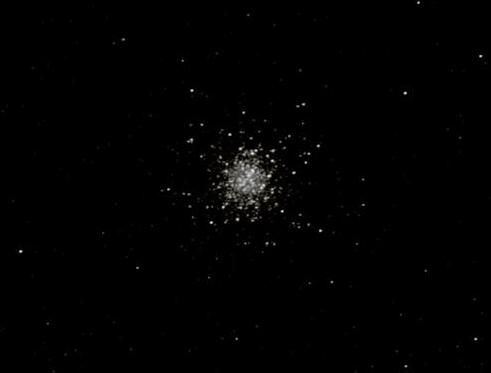|
The Night Sky of May
Dr. Wayne Wooten
Professor of Astronomy
For May 2013 , the last quarter moon rises about midnight on May 2nd. The Eta Aquarid meteor shower, debris from Halley’s Comet, peaks on the morning of May 6th, with the almost new
moon not a problem; this shower typically produces a meteor every two-three minutes from the south east. This new moon produces an annular solar eclipse for the South Pacific and Australia on May 10th. The waxing
crescent moon passes 2 degrees south of Jupiter in western twilight on May 12th. The first quarter moon is high overhead at sunset on May 18th. The waxing gibbous moon passes three degrees south of Saturn on May
24th, and the following evening is the Full Moon, the Rose or Strawberry Moon. The last week of May finds the moon waning in the morning sky, with the moon reaching the second last quarter of May on the 31st.
Mercury and Venus come out into the evening sky after sunset this month, and join Jupiter for a spectacular conjunction on the evening of May 27th. Venus will be the brightest of the
trio, with Jupiter just to the left of it, and Mercury, faintest of the three, above Venus. This will be a great photo op about 45 minutes after sunset, but if also is a final chance to see the giant planet Jupiter
before it gets lost in the sun’s glare in early June. Venus however will be visible as the "evening star" for the rest of the year, getting higher in the evening sky; at the end of May, it will a tiny telescopic
disk, 96% illuminated, but only 10" across. It will get bigger as it overtakes the earth in the next several months, but will wane in its phase as we see more and more of its night side.
Mars is behind the Sun this month, but returns to the morning sky by July. Saturn is the brightest object in the southeast as darkness falls; it lies east of the bright star Spica in
Virgo feet now. It is up all night, having reached opposition on April 28th. Its rings are now opened up to 18 degrees, much more visible than when they were edge-on during 2010’s Saturnian Equinox. You may also see
some belts and zones on the planet’s disk. The largest moon, Titan, will be seen in any small telescope, but others will need larger scopes to spot. As the planet is not now as bright as when the bright rings are
tilted more open at solstice in 2017, up to six moons may be spotted with an eight inch telescope.
The winter constellations will soon be swallowed up in the Sun’s glare, but Orion is still visible, with its famed Orion Nebula, M-42, seen below the three stars marking his famed
belt. Dominating the southwest is the Dog Star, Sirius, brightest star of the night sky. When Sirius vanishes into the Sun’s glare in two months, this sets the period as "Dog Days".
The brightest star in the NW is Capella, distinctively yellow in color. It is a giant star, almost exactly the same temperature as our Sun, but about 100X more luminous. Just south of
it are the stellar twins, the Gemini, with Castor closer to Capella, and Pollux closer to the Little Dog Star, Procyon.
Overhead, the Big Dipper rides high. Good scouts know to take its leading pointers north to Polaris, the famed Pole Star. For us, it sits 30 degrees (our latitude) high in the north,
while the rotating earth beneath makes all the other celestial bodies spin around it from east to west. If you drop south from the bowl of the Big Dipper, Leo the Lion rides high. Note the Egyptian Sphinx is based on
the shape of this Lion in the sky.
Taking the arc in the Dipper’s handle, we "arc" SE to bright orange Arcturus, the brightest star of spring. Cooler than our yellow Sun, and much poorer in heavy elements, some believe
its strange motion reveals it to be an invading star from another smaller galaxy, now colliding with the Milky Way in Sagittarius in the summer sky. Moving almost perpendicular to the plane of our Milky Way, Arcturus
was the first star in the sky where its proper motion across the historic sky was noted, by Edmund Halley. Just east of Arcturus is Corona Borealis, the "northern crown", a shapley Coronet that Miss America would
gladly don, and one of few constellations that look like their name. The bright star in the crown’s center is Gemma, the Gem Star.
Spike south to Spica, the hot blue star in Virgo, then curve to Corvus the Crow, a four sided grouping. As noted earlier, Saturn is the only planet now in the evening sky, and is
located to east of Spica, and more yellow in color and slightly brighter than Spica as well. Our large scopes will show members of the Virgo Supercluster, a swarm of over a thousand galaxies about 50 million light
years away from us. And the feet of Virgo are home to the ringed wonder Saturn for the next several months.

To the northeast Hercules rises, with his body looking like a butterfly. It contains one of the sky’s showpieces, M-13, the globular cluster faintly visible with the naked eye. Find
it with binoculars midway on the top left wing of the cosmic butterfly, then take a look with a larger telescope and you will find it resolved into thousands of stars! This fine photo shows how it looks in an eight
inch telescope. It will be a highlight of our stargazes over the next several months.
Read past issues of the Sky at Night
|